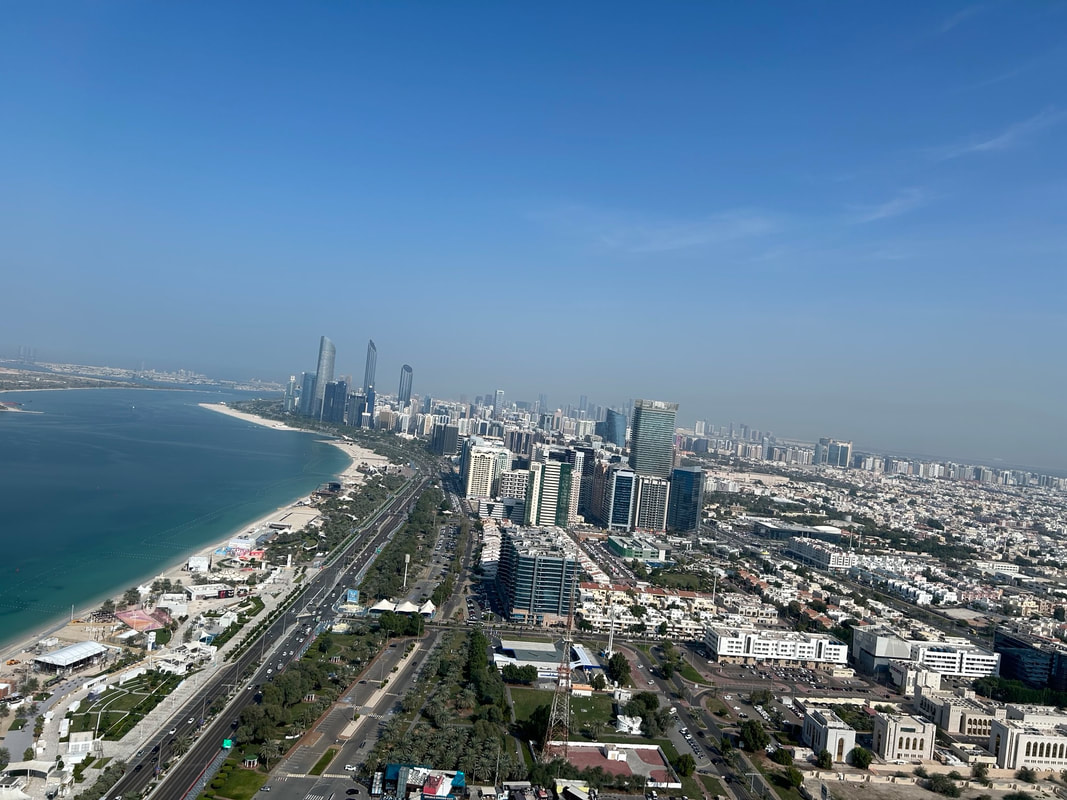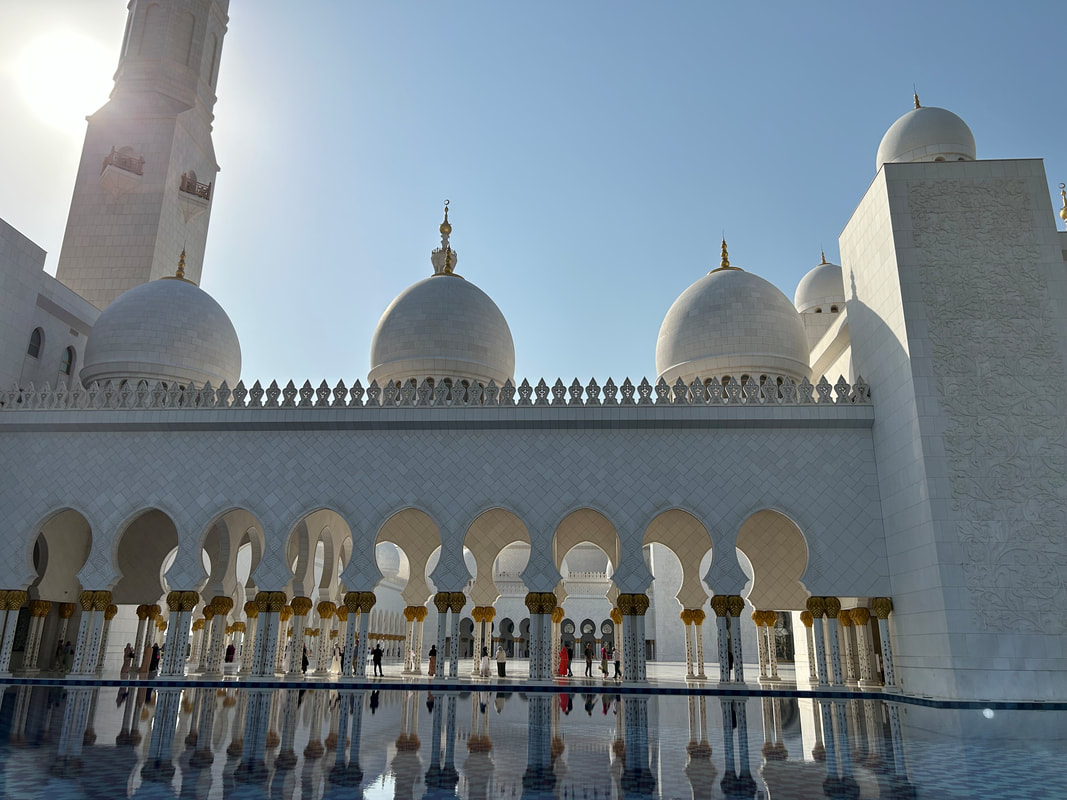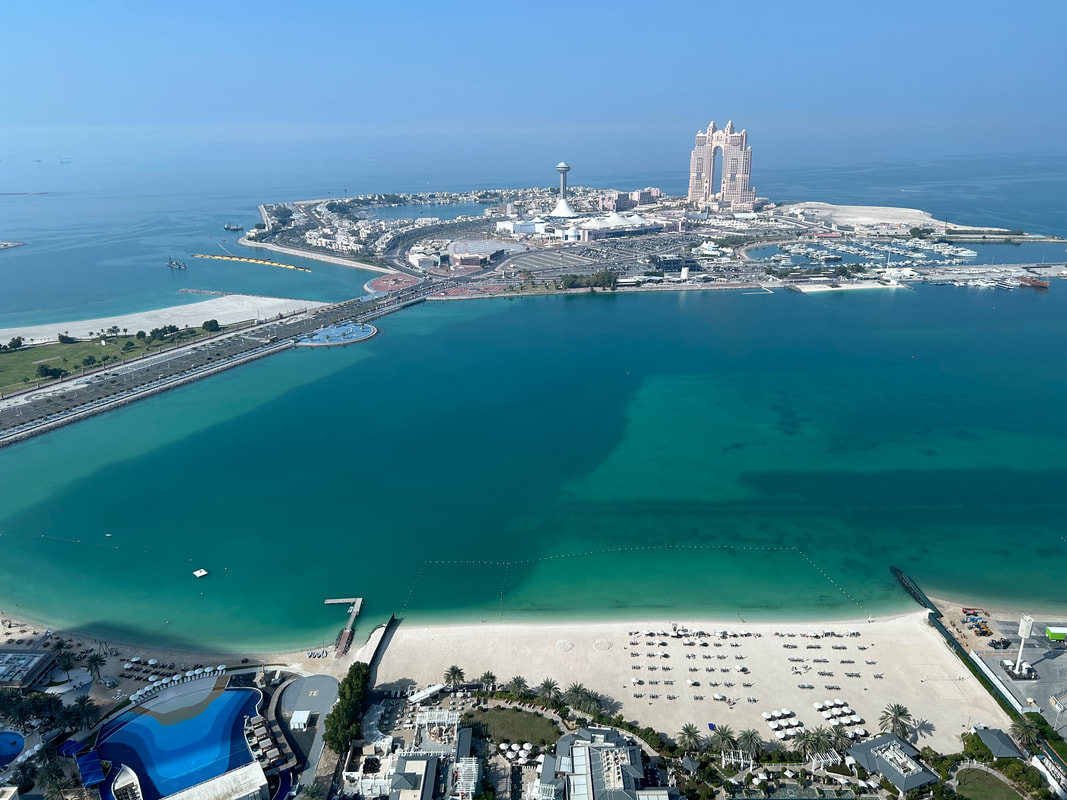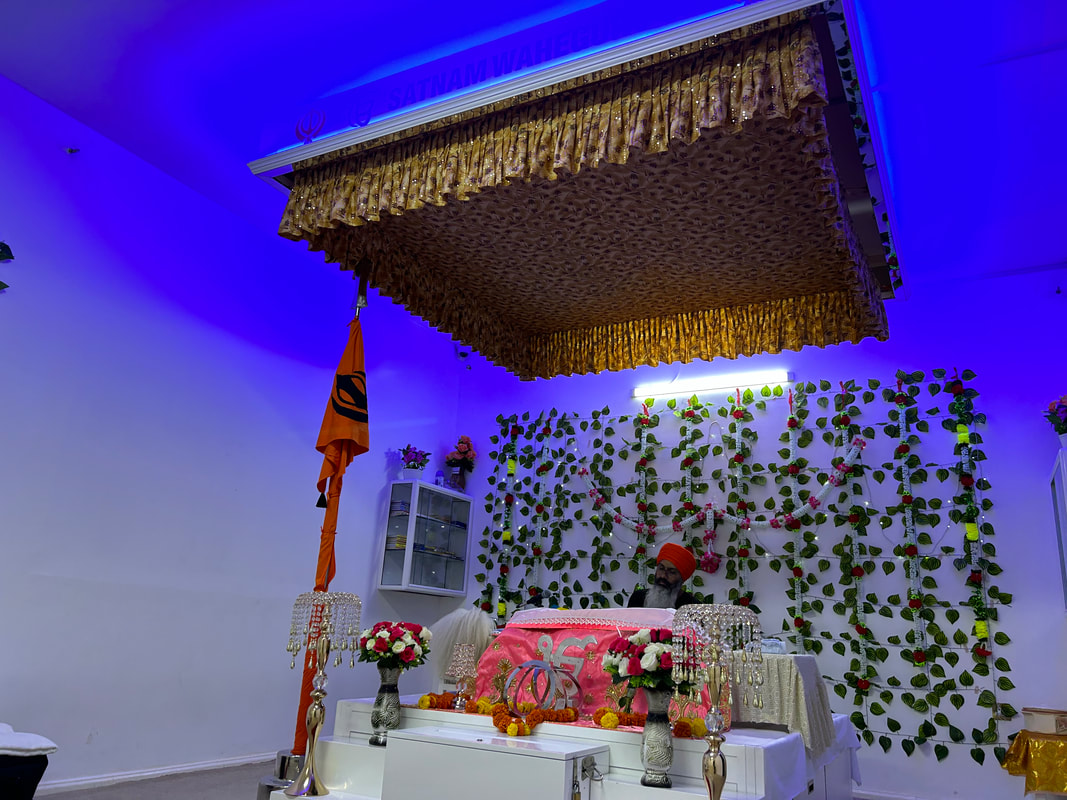SummaryAirport Rating ***** Reception of locals ***** Cost: £££££
Richer and more reserved than DubaiDubai might get all the attention, but Abu Dhabi is the capital city of the United Arab Emirates, and the richest of the cities in the Emirates. Abu Dhabi's history dates back to the 18th century when it was a small fishing village. The Bani Yas tribe, led by the Al Nahyan family, settled here in 1761. The discovery of fresh water on the island kick started its initial development while the city's geographic position made it an important trading post. However, other than strategic relevance and a small fishing and pearling industry, Abu Dhabi was a relatively quiet and small settlement surrounded by desert. The turning point in Abu Dhabi's history came in the mid-20th century with the discovery of oil. In 1958, significant oil reserves were found, dramatically altering its economic landscape. As oil revenues began to flow in the 1960s, Sheikh Zayed bin Sultan Al Nahyan, the ruler of Abu Dhabi, embarked on a massive infrastructure development program, transforming the city into a modern metropolis - a little like what was happening in cities around the Arabian Peninsula. In 1971, Abu Dhabi became the capital of the newly formed UAE, a federation of seven emirates. This union was largely attributed to the efforts of Sheikh Zayed, who saw the value in unifying the emirates against regional uncertainties. While Dubai and Abu Dhabi are the most prominent emirates, they have distinct developmental paths. Dubai, under the leadership of its ruling family, focused on trade and tourism, developing a reputation for tacky pretentiousness (you can read about my visit to Dubai here). Abu Dhabi, on the other hand, has historically relied on its oil wealth, which has fueled its development. The relationship between Abu Dhabi and Dubai is characterised by both collaboration and rivalry. They work together on several national initiatives but also compete in areas like tourism, aviation, and financial services. In my conversations with Emirati locals (and they make up a small minority of the population at about 19%) you could hear the rivalry in each conversation that mentioned Dubai. Abu Dhabi is the wealthiest emirate in the UAE due to its substantial oil reserves, which account for the majority of the UAE's oil production. This wealth has enabled significant investments in infrastructure, healthcare, education, and cultural institutions, as well as bailing Dubai out on occasion when its sister city has struggled with debt. The thing that really sets Abu Dhabi apart, for me, is the fact it has maintained more of its cultural heritage and the fact that it has a more relaxed pace of living compared to Dubai. It's more conservative than Dubai, but also has admirable projects on unifying humanity. Abu Dhabi AirportI've passed through Abu Dhabi airport before, but I'd never spent any real time in the city so I welcomed the opportunity to spend a week here and see how it stacks up against Dubai, but also other cities on the Persian Gulf that I have visited before like Doha and Kuwait City (which you can read about here). I landed at Abu Dhabi airport, a stylish modern airport that's been operational since 1982. The airport is structured into three main passenger terminals. Terminal 1 has a functional circular design, built to efficiently utilise space and reduce transit times between gates. Terminal 2 was constructed to handle the surge in low-cost and regional flights. Terminal 3, predominantly used by Etihad Airways, the UAE's national carrier, was added to increase capacity and streamline operations for the airline. The airport is nice. It's not quite as OTT as Dubai and it focuses more on quality and efficiency and for those reasons I preferred it to Dubai's airport. As a Sikh, I had no problems with any security or secondary checks, although - like many other airports in the region - there are multiple security lines so it can be a bit long getting through. The Emiratis man some of the immigration stands and the ones I came across were not the friendliest or most efficient. Magnificent MosquesI caught a taxi into the city as public transport in Abu Dhabi is awful with few public buses and no metro system. Taxis aren't cheap, particularly when you consider how heavily subsidised petrol is in the region, but you can use Uber and it is reliable. Driving from the airport to the city, I immediately saw the magnificent Sheikh Zayed Grand Mosque. This mosque is one of the largest in the world and even from the distance of a nearby motorway the landmark looked gigantic. As soon as I had settled into my hotel, I hopped back into a taxi, and headed to the mosque. Conceived in the late 1980s, the construction of the mosque began in 1996 and was completed in 2007. The process involved a significant international effort, with materials sourced from around the world, although the labour was predominantly from South Asian countries (India, Pakistan, Panjab, Bangladesh, and Sri Lanka). First things first - you need to book a ticket in advance. It costs nothing but it does give you a specific timeframe. I managed to sneak into the perimeter (without even realising I was sneaking in) and got into the mosque, however, in order to see the famous carpets and chandeliers inside there was a secondary check. As I left the complex disappointed in missing out, I saw a small queue of people using a QR code to register for on the day tickets and managed to get one and re-enter. The mosque’s architectural style blends elements from different Islamic traditions, including Mamluk, Ottoman, and Fatimid designs. The mosque can accommodate over 40,000 worshippers (or almost 15% of Abu Dhabi's Emirati residents), with the main prayer hall holding up to 7,000. Its construction features Macedonian marble, contributing to its notable white appearance. And the appearance is extraordinary, it looks like a shining jewel in this desert city. A distinctive aspect of the mosque is its interior, which houses one of the world's largest hand-knotted carpets and one of the largest chandeliers, decorated with Swarovski crystals. You could previously walk over the carpets, but with greater tourism numbers the whole section is now cordoned off. The mosque's 82 domes, the largest of which is located in the main prayer hall, and the interior walls are adorned with Islamic motifs and calligraphy. I tried to count 82 and didn't come anywhere near, but I trust the numbers. I thought the whole thing was absolutely stunning but, much like fancy Gurdwaras in the UK (which you can read about here), I always wonder whether the cost of construction is worth the outcome. The project cost at least half a billion pounds so you know religion is not the primary driver given that Islam promotes humility. The main driver is tourism, but you have a carpet so fancy that you can't walk on it and what is, in essence, the disneyfication of religion (and believe me, the same thing is happening in Sikhi with all the Gurdwara "upgrades" in Panjab). It wasn't quite as ridiculous as what I saw in Astana (which you can read about here), and I must admit - it is beautiful - but if the primary driver is tourism, only time will tell if it makes back its cost of construction. Unifying the (Abrahamic) worldWhile a conservative Emirate, Abu Dhabi is positioning itself as a unifier of humanity, and while strongly Islamic in character, it does allow worship of other faiths. Perhaps nothing demonstrates this more than the Abrahamic Family House. The aim of the Abrahamic Family House is to foster interfaith dialogue and understanding. This complex, situated on Saadiyat Island in Abu Dhabi, is designed to be a physical manifestation of the UAE’s commitment to religious tolerance and cultural diversity. The project consists of three religious spaces: a mosque, a church, and a synagogue, each dedicated to one of the major Abrahamic faiths: Islam, Christianity, and Judaism. The concept of the Abrahamic Family House was inspired by the “Document on Human Fraternity for World Peace and Living Together”, signed in February 2019 by Pope Francis and the Grand Imam of Al-Azhar, Ahmed el-Tayeb. This declaration called for peace, dialogue, and mutual understanding among followers of different faiths, particularly the Abrahamic religions. The project was announced in September 2019 by the Higher Committee of Human Fraternity, an independent international committee instituted to promote the goals set out in the Document on Human Fraternity. The complex aims to reflect the shared values and commonalities of the three faiths while respecting their unique identities. Each of the three religious spaces – the Imam Al-Tayeb Mosque, St. Francis Church, and Moses Ben Maimon Synagogue – is designed to be of equal size and stature (they can all accommodate about 300 worshippers), symbolising the equality and mutual respect among the faiths. The architectural designs avoid overt religious symbols, focusing instead on creating spaces conducive to worship and reflection for each faith. Entering the Abrahamic Family House is free, but you do need to book timed tickets in advance. The complex is part of the cultural quarter of Abu Dhabi, an area that is being extensively redeveloped and was basically one giant construction site when I got there. The entrance to the Abrahamic Family House isn't easy to find - the taxi driver got lost, I got lost - but eventually one of the workers saw me walking around and shepherded me into an underground car park through which I had to enter. I really like the concept of the Abrahamic Family House. I entered the mosque first, the church second, and the synagogue third and each building is a similar size, with a similar style although with some design differences. I liked the pure simplicity of the mosque, the beautiful roof of the synagogue, and the ceiling of the church. Seeing women in full Arabic veil standing in a church seemed pretty surreal and seemed to support the aim of the project. On top of the complex is a really nice rooftop with soft drinks and food and it gives a nice view of the developing cultural quarter as well as the three houses of worship. To me, this was one of the best things I have seen in the UAE. Drones and loansNearby in the cultural quarter is the Louvre Abu Dhabi, which is a collaboration between the UAE and France that aims to bridge the gap between Eastern and Western art. Inaugurated in November 2017, this museum is based on a 30-year agreement which includes the loan of the Louvre name, temporary art exhibitions, management expertise, and the loan of artworks from French institutions. The total cost of the project was estimated at around £1 billion, making it one of the most ambitious cultural projects in the Middle East. The design of the museum is pretty cool, especially the vast, geometric-patterned dome that covers much of the museum, creating a 'rain of light' effect, inspired by the interlaced palm leaves traditionally used in Emirati roofing. This design not only provides shade and reduces heat, but also creates a nice atmosphere within the museum complex. Here's the issue - the UAE has little to no history - nor has it gone around looting and plundering half the world, so having a museum here is always going to be a strange decision other than to show off, spend some of that sweet, sweet oil money, and attract some tourists. Most of the pieces are loaned from the Louvre and other French museums such as the Musée d’Orsay and the Centre Pompidou. The artifacts that are local are few and far between. The museum feels more like an art gallery than an actual museum given that it feels so empty. Much of the attraction is the building itself rather than the pieces it contains. The cost of entry is AED 63 which is about £15. My recommendation, save the money and don't bother. But that doesn't mean don't visit the surrounding area. Each evening, outside the museum is a very nice drone show. People begin finding nice viewing areas about 30 minutes before starting, but it didn't feel overly busy. This show features hundreds of drones creating spectacular formations in the sky, including representations of famous artworks and the museum's logo. It's a nice experience, albeit a little slow. A very expensive and OTT palaceAnother famous landmark in Abu Dhabi is the Qasr Al Watan, a palace built around 20 years ago that looks like something from the Disney version of Aladdin. Again, you need to book tickets in advance, although you can also buy tickets on the day. It's located a decent walk from the main Corniche area so it might be better to get a taxi. I decided to walk in the afternoon sun and it was a pretty uncomfortable experience. Tickets cost AED 60, so a little over £13, but it's worth the entrance, although my usual moral dilemma about its construction exists. There are large palaces all of the world, many of them built hundreds of years ago under dictatorial rulers and monarchs, and most of us consider them a waste of money that could have been better used for public infrastructure projects while some have stood the test of time and become cultural icons. This was built 20 years ago, but time will tell how it is viewed in the future. It's so ridiculously over the top. That's not to say it isn't impressive, but this is what happens in the absence of the wider population having a say in big decision about the society that they live in. At the entrance there is a coach that takes you to the main complex. The palace is huge and the use of white granite and limestone in the construction gives the palace its distinctive appearance. The palace's architecture draws heavily from traditional Islamic and Arabian design elements, including intricate geometric patterns, expansive courtyards, and ornate archways. The interior is equally impressive, featuring vast halls, extensive use of gold and marble, and elaborate chandeliers, all of which are meant to represent the richness of Arabian culture and hospitality. Qasr Al Watan serves multiple functions. It is a working palace, hosting official state visits and government meetings. However, it is also a cultural hub, offering public access to its gardens, several exhibition halls, and libraries. The exhibitions within the palace provide insights into the governance, culture, and history of the UAE, including its political structure and the vision of its leaders. One of the key attractions within Qasr Al Watan is the vast library, which houses a significant collection of books and resources on the UAE’s history, culture, and development. The library is aimed at scholars and researchers, but it is also accessible to the general public, making it a resource for anyone interested in learning about the country's heritage. I've been a little harsh with the UAE, so I also want to be fair with things that I enjoyed, and I really liked an exhibit in the palace that showcased the gifts that the UAE ruling family have received from diplomatic visits from across the world. I'm not naive to believe that all the gifts are here, but the fact that at least some proportion of the gifts are shared with the wider public is admirable. The UAE, one giant shopping centreNot too far from the palace is the Marina Mall. I've mentioned many times over the years that sometimes Gulf countries feel like one big shopping centre, and although that isn't quite fair about Abu Dhabi, it wouldn't be an emirate without at least one large shopping centre. Marina Mall opened in 2001, at a time when Abu Dhabi was expanding its infrastructure and investing heavily in urban development to try and become a global city. The shopping centre spans approximately 122,000 square meters of retail space, with a wide array of shops, a hypermarket, a cinema, and various entertainment and dining options. It offers a mix of high-end and mid-range retail brands, and while there are a lot of shops, it felt a little run down when comparing to shopping centres in Dubai, and particularly the Avenues in Kuwait City. I'm not a huge shopping person, and these giant shopping centres will never be something that interest me - but if you like shopping for mid-end products at high prices, and high-end products for even higher prices - this is the place for you. If it sounds French, it must be luxuriousThe name "Corniche" pops up as a seaside area in cities across the Gulf Coast. It's a French term that refers to a road that cuts into a cliff. It doesn't matter if there aren't any cliffs, a French sounding word brings in the tourists. In Abu Dhabi, the Corniche is a 6-mile long waterfront promenade that stretches from the Hilton Hotel to Al Khaleej Al Arabi Street, used by residents and tourists to take evening walks as well as a place to do exercise, or get together and hang out in the many restaurants that line the stretch, The Corniche's design and construction involved significant landscaping, the creation of pedestrian pathways, bicycle tracks, children's play areas, and the establishment of various beaches along the waterfront. This had a massive environmental impact in terms of dredging up the seafloor and the ongoing maintenance of landscaped gardens and freshwater in a desert is insane. The beaches along the Corniche are segmented into different sections, catering to various groups, including a family beach, a public beach, and a beach for water sports enthusiasts. While there are a lot of public beaches, many of the beaches are attached to hotels or a private properties which can mean they are off limits to most of the normal residents (the other 80% of the population). GurdwaraWhenever I have visited Gurdwaras in Gulf countries, they are all given land far, far out from the city centre, and they almost feel like they are placed to make then inconvenient as possible for people to get to. The Gurdwara in Doha is particularly guilty of this, but I could also say the same for the Gurdwara in Dubai. Abu Dhabi has two Gurdwaras, and one of them, Guru Nanak Darbar, is located right in the middle of the city. I was incredibly surprised when I first realised this, and it further supports Abu Dhabi's vision of treating other religions with respect, if not equally. The government of Abu Dhabi allocated land for the Gurdwara in 2009 and construction began shortly after. The Gurdwara was officially inaugurated in 2012. The architecture of the Gurdwara is a blend of modern design with traditional Sikh architectural elements, featuring the iconic domes and arches that are characteristic of Gurdwaras. It's a decent size but much, much smaller than the Gurdwara in Dubai. The funding for the Gurdwara came largely from donations from the Sikh community in the UAE and worldwide and has become a hub for the Sikh community in Abu Dhabi and the surrounding regions. I thought the location was excellent, the building style of the Gurdwara was also a nice mix of humility while providing a space large enough for the sangat. The only issue was that it doesn't seem to have been kept as clean as it should. There was standing stagnant water, and the whole of the entrance was covered in flies. During my whole stay in Abu Dhabi, I wasn't bitten by a single mosquito, but I sat inside for about 30-45 minutes in the darbar sahib and I was bitten at least 5 or 6 times. It's a shame, because I think the Gurdwara is beautiful. Would I recommend visiting Abu Dhabi?It's difficult to say because of the place I'm in life. Right now, without kids, there is absolutely no reason to go to Abu Dhabi - perhaps when I get married and have kids I might feel differently. Hopefully I won't. And look, if this is for you and you like it, good for you. Sometimes people want to go somewhere, get pampered, feel safe, and have plenty of activities for their kids. There is nothing wrong in wanting that and coming here. I'm not going to be overly harsh or critical. The truth is Abu Dhabi is much better than Dubai, but the bar is quite low there. I prefer that this city feels less dense, more open, and not populated by pretentious or downright trashy influencers. I like some of the cultural places like the Abrahamic Family House, and give lots of props for the city leaders for the location of the Gurdwara. The airport is super nice and works well but other than that, I'm not sure I could recommend visiting here, particularly if you are younger. Comments are closed.
|
AuthorBritish Sikh, born in the Midlands, based in London, travelling the world seeing new cultures. Categories
All
|












 RSS Feed
RSS Feed